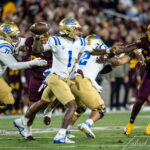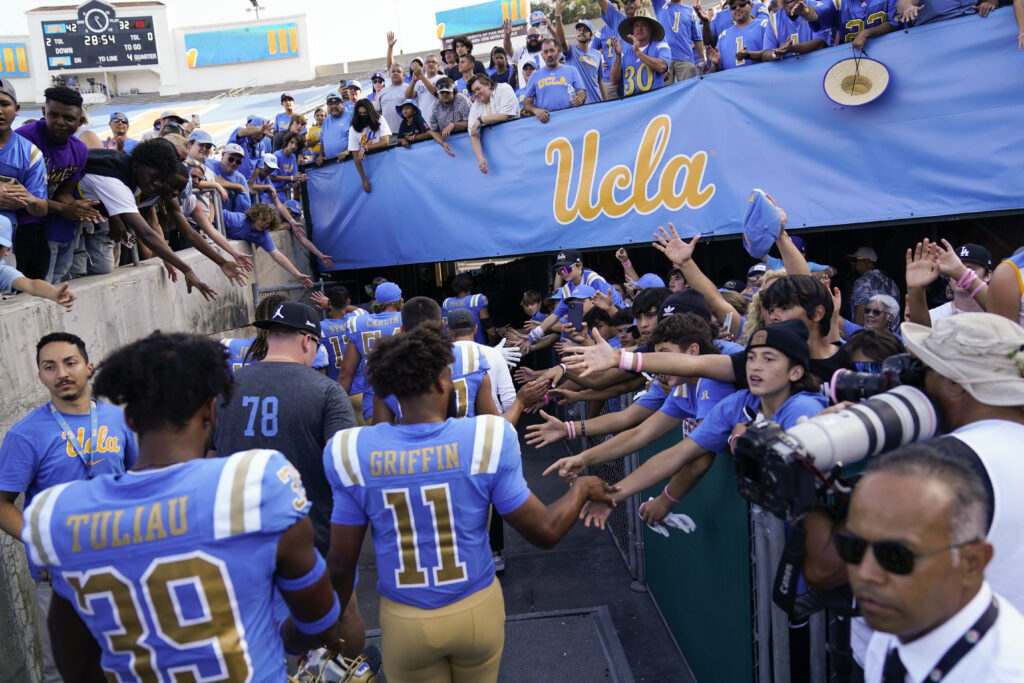UCLA completed an exchange of head coaches on Monday morning, 24 hours ahead of its self-imposed deadline.
The Bruins finalized the swap of Chip Kelly, winner of 81 college games and one of the most respected playcallers in the sport, for DeShaun Foster, a former UCLA running back who has never been a head coach or coordinator.
That is, admittedly and intentionally, a gross oversimplification — for Kelly had a deeply flawed tenure in Westwood and Foster brings significant potential to the role.
But the juxtaposition helps frame the challenge in Westwood, where a once-proud program has gone 25 seasons without a conference title, burned through five head coaches this century and failed to generate traction heading into the Big Ten.
Kelly, who departed late last week to become Ohio State’s offensive coordinator, hated to recruit. He didn’t connect with players, failed to energize fans and made little effort to cultivate donors for the purposes of creating an NIL (name, image and likeness) war chest.
He bears significant responsibility for the current state of affairs — but not all of it.
Foster, who coached under Kelly last season, bleeds blue and gold. He relates well to the players and has both the energy and passion necessary for high-level recruiting. But success in the Big Ten is about more than Foster — much more.
Upon announcing the news of Foster’s appointment on Monday morning, the Bruins described him as “a leader of young men.” To date, he has led the UCLA running backs as their position coach for the past seven years. Soon, we will know if he can lead a team, if he can engage donors and work with central campus and manage the media and handle all the tasks baked into running a major college football operation.
Foster gives UCLA a chance to keep the coaching staff intact and prevent an exodus of players into the transfer portal with the Big Ten opener seven short months away. Also, he’s cheap. The Bruins paid Kelly $6 million per year. That cost will be cut in half (approximately) with Foster’s promotion — an important element for a department deep in the red.
Those fiscal challenges might get worse before they improve.
Yes, the Bruins will begin collecting Big Ten paychecks next season, but they will also start accruing Big Ten expenses — the cost of doing cross-country business in the nation’s richest conference.
And they could very well have to subsidize Cal by as much as $10 million annually if the UC regents implement a policy approved in late 2022.
We also should not forget about the leadership void on campus. Chancellor Gene Block is retiring this summer. There’s a strong chance the next boss will care more about football than Block ever did, but it’s not guaranteed.
Foster faces a slew of football-specific challenges, as well, from the holes in the depth chart to the grueling schedule to the lack of an NIL support structure essential for roster strength and stability. (The Bruins are planning to ramp up their NIL efforts this offseason.)
Put another way: To a significant degree, it doesn’t matter who’s coaching UCLA in 2024 and beyond.
The Bruins are entering the Big Ten at a steep competitive and financial disadvantage compared to the top teams in the conference. They are at risk of a slow start in their new home that could have a lasting impact on the entire endeavor.
Foster will need help, and loads of it — not only from athletic director Martin Jarmond, who has a personal stake in Foster’s success, but from the institution itself.
For decades, UCLA’s administration has declined to move in lockstep with its athletic department, to go all-in with football.
Not the way USC and Oregon and Ohio State and Michigan are all-in with their football programs.
Not even the way Washington is all-in with football, which is a half-degree less than the aforementioned quartet.
For Foster to succeed where his predecessors failed, the Bruins need central campus to stop its practice of social distancing and embrace football.
Foster needs to sell season tickets, but central campus needs to stop commandeering the concession revenue from basketball games in Pauley Pavilion.
Foster needs to engage donors and convince them of the importance of NIL, but so does the next chancellor.
Otherwise, nothing will change.
In fact, it could get worse. Because of the financial and competitive pressures accompanying the Big Ten move and the disruptions to the NCAA model, the terrain under Foster’s feet is more challenging, more complicated and more ominous than anything his predecessors faced.
Will the Foster experiment work? It depends, first and foremost, on the support.
*** Send suggestions, comments and tips (confidentiality guaranteed) to pac12hotline@bayareanewsgroup.com or call 408-920-5716
*** Follow me on Twitter: @WilnerHotline
*** Pac-12 Hotline is not endorsed or sponsored by the Pac-12 Conference, and the views expressed herein do not necessarily reflect the views of the Conference.
Related posts:
 Pac-12 rewind: Washington survives, Nix shines, Allen delivers, WSU bounces back and the L.A. schools keep scoring (and scoring)
Pac-12 rewind: Washington survives, Nix shines, Allen delivers, WSU bounces back and the L.A. schools keep scoring (and scoring)
 Hotline mailbag: Peeking at the ’23 schedules, expansion timeline, buyer’s remorse in L.A.(?) and loads more
Hotline mailbag: Peeking at the ’23 schedules, expansion timeline, buyer’s remorse in L.A.(?) and loads more
 Pac-12 financial mess: On the fate of the networks, an emergency recourse and the legal framework
Pac-12 financial mess: On the fate of the networks, an emergency recourse and the legal framework
 Wilner: Kliavkoff’s risky strategy, an alternate Pac-12 universe (with ESPN), the MLS on Apple, unequal revenue shares and more
Wilner: Kliavkoff’s risky strategy, an alternate Pac-12 universe (with ESPN), the MLS on Apple, unequal revenue shares and more
Jon Wilner
Jon Wilner has been covering college sports for decades and is an AP top-25 football and basketball voter as well as a Heisman Trophy voter. He was named Beat Writer of the Year in 2013 by the Football Writers Association of America for his coverage of the Pac-12, won first place for feature writing in 2016 in the Associated Press Sports Editors writing contest and is a five-time APSE honoree.
